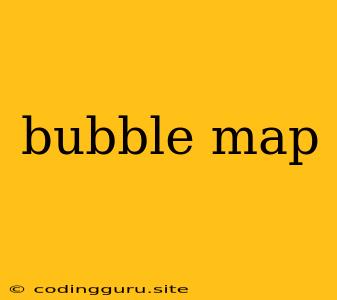What is a Bubble Map?
A bubble map is a visual tool used to organize and represent information in a structured and hierarchical manner. It's a versatile tool that can be used for various purposes, from brainstorming ideas to analyzing data.
How does a bubble map work?
The central idea behind a bubble map is to represent information in a way that emphasizes the relationships between different concepts. It typically starts with a main idea or topic placed in the center, represented as a large bubble. From this central bubble, branches extend outward, each representing a sub-topic or supporting concept. These sub-topics are also represented as bubbles, and they can further branch out into smaller bubbles, representing details or examples.
The size of the bubbles can be adjusted to reflect the importance or prominence of the information they represent. This visual hierarchy helps to quickly grasp the main idea and its supporting points.
Why use a bubble map?
There are several benefits to using a bubble map:
- Brainstorming and Idea Generation: Bubble maps are excellent for capturing and organizing thoughts during brainstorming sessions. They allow you to freely connect ideas and discover new relationships.
- Conceptual Mapping: Bubble maps are effective for visualizing complex concepts and their interconnectedness. This is helpful for understanding abstract ideas and their underlying structure.
- Data Analysis: Bubble maps can be used to analyze data by grouping and categorizing information based on common themes or patterns.
- Problem Solving: Bubble maps facilitate problem-solving by breaking down complex issues into smaller parts and identifying potential solutions.
- Presentation and Communication: Bubble maps provide a clear and concise way to present information in a visually appealing format, making it easier for audiences to understand complex ideas.
How to create a bubble map
Creating a bubble map is a simple process that involves the following steps:
- Define the Main Topic: Identify the central idea or topic that you want to map.
- Create the Central Bubble: Draw a large circle in the center of your page to represent the main topic.
- Add Sub-topics: Draw smaller circles around the central bubble to represent sub-topics or supporting concepts.
- Connect the Bubbles: Use lines to connect the central bubble to its sub-topics, indicating relationships and hierarchy.
- Add Details: You can further elaborate on the sub-topics by adding smaller bubbles that represent specific details, examples, or supporting arguments.
- Label the Bubbles: Clearly label each bubble with the appropriate text to represent the information it contains.
Examples of Bubble Maps
Bubble maps can be used in various contexts. Here are a few examples:
- Science: A bubble map can illustrate the different parts of a plant and their functions.
- History: A bubble map can depict the major events leading up to a historical event.
- Marketing: A bubble map can be used to brainstorm marketing strategies for a new product.
- Education: A bubble map can help students understand complex concepts in a visual way.
Tips for Creating Effective Bubble Maps
- Keep it Simple: Start with a clear main topic and focus on the most important sub-topics.
- Use Visual Cues: Different colors, sizes, and shapes of bubbles can help to emphasize specific information.
- Be Creative: Don't be afraid to experiment with different layouts and styles to create a visually appealing map.
- Collaborate: If you are working in a team, collaborate on creating the bubble map to gather diverse perspectives.
Conclusion
Bubble maps are a valuable tool for organizing information, brainstorming ideas, and analyzing data. They provide a visual representation of relationships and hierarchies, making it easier to understand complex concepts. By following the steps outlined above and utilizing the tips for creating effective maps, you can leverage this versatile tool to enhance your communication, problem-solving, and decision-making processes.
